Collaboration is integral for any organization, regardless of your business’s industry.
By working as a team, you can often accomplish more than you would by working alone.
Collaboration can also plant the seeds for new initiatives, shed light on different perspectives, and motivate team members to produce high-quality work.
However, building a healthy team isn’t something that can happen overnight.
Discover the hallmarks of a positive, thriving team and ways to create empowerment, focus, and trust.
How Can You Accomplish More by Working as a Team?
Although it may seem like you can achieve more tasks by powering through independently, collaborative work allows you to complete tasks more efficiently.
Let’s say that you and your friend each have couches you need to move.
If you each move your own couch, you will face many more difficulties and problems.
You may get injured and need to stop the project until you feel better.
It will also take a much longer time for you to move the couch on your own.
But what if you and your friend worked together and helped each other move the couches?
It will be significantly easier to have two people moving two couches than if you each moved a single couch by yourself.
And, as we’ve seen in Friends, sometimes you need more than two people when moving couches.
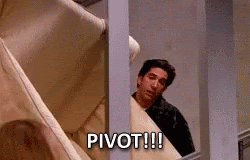
If three of the Friends had this much trouble moving a couch, imagine how difficult it would be to move a couch alone.
If you work as a team, you can increase output and speed while reducing strain and difficulty.
What is an Example of an Unhealthy Team?
Unhealthy teams share similar characteristics—poor culture, lack of communication, and absence of trust.
The Disney-Pixar short “For the Birds” features a clear example of an unhealthy team.
In the short, a new bird has come to join a community of other birds on a telephone wire—but the team is not too happy about his presence.

Even though the new bird is friendly and waves hello, the team gossips about him and mocks his actions.
Eventually, the new bird flies over to join the team on the telephone wire.
But the team doesn’t welcome him into their flock with open wings.
Instead, they try everything in their power to force him off of the telephone wire so they can maintain their original team structure.
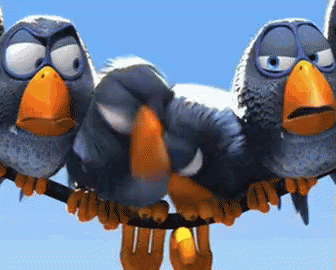
As they’re forcing him to leave, one of the birds realizes something is wrong.
The telephone wire is getting closer and closer to the ground, and if they continue in the same way, the results will be disastrous.
But it’s too late.
When the new bird is forced off the telephone wire, the entire wire snaps up in the air, sending the team of birds flying in all directions.
Except for the new bird, all the birds lose their feathers and are incredibly embarrassed.
Think about this like a workplace.
Although there wouldn’t be snapping telephone wires and gossiping birds at your company, these same issues can occur.
Miscommunication, individualistic mindsets, and an unwillingness to change can harm teamwork and your company.
By failing to work together and spending their efforts sabotaging their teammate, the birds only sabotaged themselves in the long run.
Eventually, their team (if you can call it that) imploded.
What are Some Pitfalls When You Don’t Have Effective Team Collaboration?
Without effective team collaboration, work efficiency, productivity, and quality suffer.
Other consequences of poor team collaboration include:
- Loss of motivation
- Fewer tasks getting done
- Wasted time
- Miscommunication
- Lack of goals to work towards
- Focus on individual goals instead of team goals
Poor team collaboration doesn’t only impact that specific team.
It also affects other aspects of your company because of lower efficiency levels and a lack of goal achievement.
What are the Characteristics of an Unhealthy Team?
The characteristics of an unhealthy team can be thought of as a pyramid, as shown in Patrick Lencioni’s book The Five Dysfunctions of a Team.
These problems begin with a foundational absence of trust, eventually leading to more issues.
You can also think of this as an iceberg.
Most icebergs are submerged in the ocean, with just their tips showing.
The top of this pyramid is Inattention to Results, the main characteristic displayed in an unhealthy team environment.
The other characteristics would be hidden below the surface and drive an overall inattention to results.
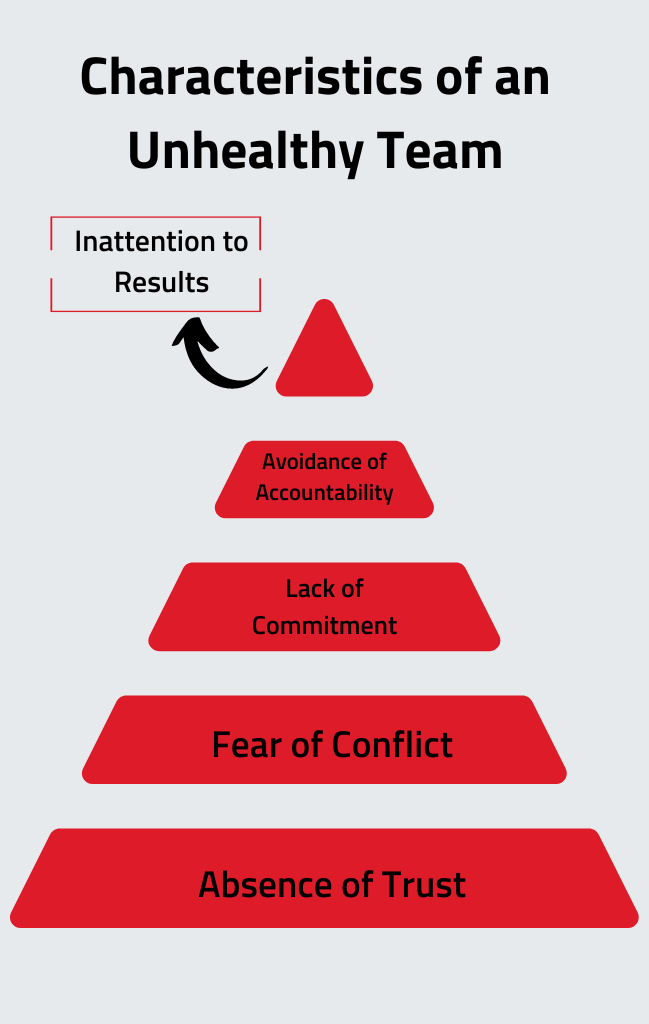
Inattention to Results
Starting at the top of the pyramid, inattention to results means that no one on your team cares about what’s happening.
There may be an accompanying need for more quality in their work.
If people do not focus on the results of their work, there is a significant problem.
Results matter.
If results don’t matter, there’s no point in completing the work.
Inattention to results could make team members wonder why they’re doing work in the first place.
Avoidance of Accountability
Inattention to results is driven by avoidance of accountability.
In unhealthy teams, teammates might frequently pass responsibility around, refuse to help, or fail to accept the consequences.
They may even say, “This isn’t my job, it’s this other person’s.”
Even if something isn’t your direct responsibility, we can all help resolve an issue or move a project toward the finish line.
For example, you could let appropriate stakeholders know you are working toward a resolution and connect with the team members who can help.
Lack of Commitment
Another characteristic of unhealthy teams is a failure to commit to completing tasks and projects.
Let’s say you’re holding a team meeting.
You need a specific report ready for a client, so you ask, “When can this be done?”
Silence.
Finally, someone says, “I don’t know.”
In this instance, the team fails to step up to the plate because they are unwilling to commit.
Even if solutions are uncertain, a healthy team works through uncertainty to honor commitments and meet expectations.
Fear of Conflict
A lack of commitment can stem from a fear of conflict.
If team members are afraid to bring up important topics and potential problems, it will lead to more significant issues.
Sometimes, people worry about speaking up because they don’t want to cause drama, create problems, or upset teammates.
In the long run, this lowers transparency and creates more problems.
Voicing your concerns to your team is crucial.
If you see an area for improvement or a small issue that may snowball into something bigger, you need to say something—even if it’s not your direct responsibility to fix it.
See something, say something.
Absence of Trust
The foundation of the pyramid, and the crux of all of these issues, is an absence of trust.
If you do not trust your team to do what’s best, it will lead to a fear of conflict, lack of commitment, avoidance of accountability, and inattention to results.
Healthy teams trust each other and work together to accomplish more.
Another hallmark of a trusting team is the ability to share transparent feedback.
If you trust your team to do what’s right, you’ll want to give them feedback because you know they will take it well, run with it, and be more successful.
A healthy team will accept criticism and work to improve.
But it all starts with trust.
We’ll discuss ways to build trust among your team later on.
What is an Example of a Healthy Team?
Healthy teams accomplish more work, have a strong sense of their roles and responsibilities, and establish trust in each other.
An example of a healthy team is the superhero family The Incredibles from the Disney-Pixar film The Incredibles.
This team has an enormous amount of trust in each other, which enables them to work together and defeat the movie’s villain.
They also take advantage of their different skills and strengths to achieve the collective goal.
For example, when Violet and her brother, Dash, are almost squished by a huge robot, Violet uses her force field to protect them both.
When Violet’s force field wavers, Mr. Incredible uses his super strength to hold off the robot so the kids can escape.
From there, Mrs. Incredible uses her flexibility and elasticity to move the kids out of harm’s way.
Although your team is likely not fending off giant robots, this is a helpful example of how teams need people with different skills to succeed.
What are Some Benefits of Healthy Team Collaboration?
With healthy team collaboration, you can continue strengthening productivity, quality, and camaraderie.
Established Trust
Trust is connected to every other aspect of team collaboration.
With established trust, your team has each other’s back, shares in the work well, and knows that tasks and projects will be accomplished.
Increased Efficiency
With healthy team collaboration, you can achieve the same amount of work in less time.
As discussed in the couch example, people can accomplish more by working together than they would individually.
Clear Knowledge of Responsibilities, Expectations, and Outcomes
Once everyone knows what they are supposed to be doing, workflows and processes can flow more seamlessly.
A strong understanding of the collective goal also helps drive work and motivate team members.
Expanded Support
Being part of a team allows you to work with other people who have varied skill sets and strengths.
You may not be able to accomplish every task independently, but working together enables you to get the help you need from a skilled teammate.
Increased Camaraderie and Confidence
By working together to overcome challenges, teams often grow closer and more resilient.
You’ll also build confidence in your team’s ability to handle and solve future problems.
Openness to Interruption
“Interruptions are Opportunities Knocking” is one of our core company beliefs here at Miles IT.
We believe interruptions are opportunities to provide guidance and support to team members so they can continue building their skill sets.
A healthy team is more likely to view interruptions as possibilities for education instead of annoyances.
What are the Characteristics of a Healthy Team?
Similar to the characteristics of an unhealthy team, the qualities of a healthy team can be visualized as a pyramid; this is also shown in Lencioni’s The Five Dysfunctions of a Team.
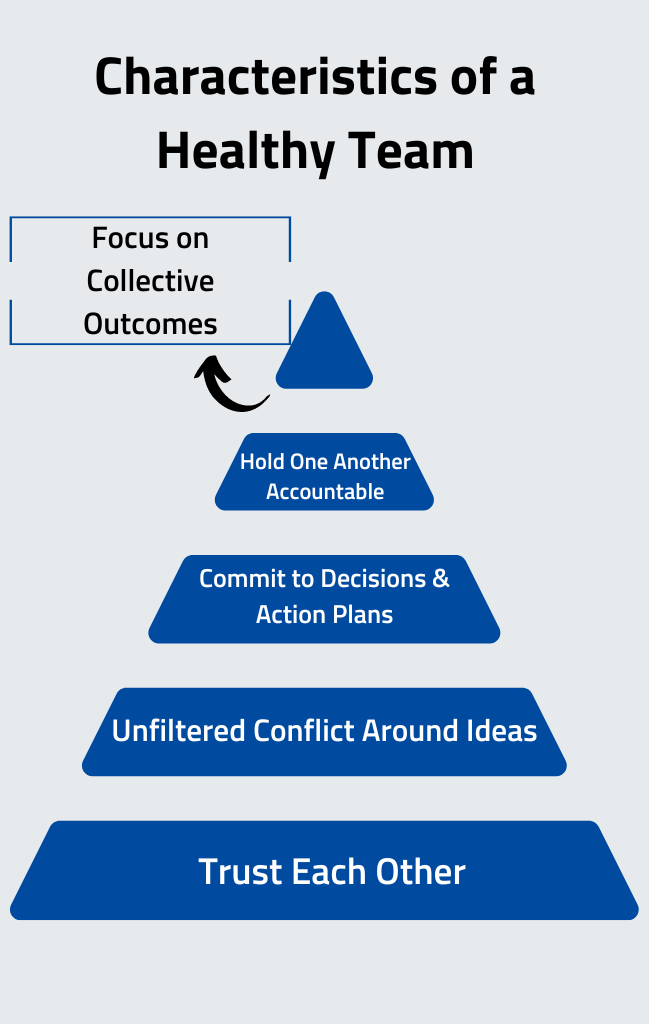
Trust Each Other
The foundation of the pyramid is trust; any healthy team needs a strong foundation of trust to work together well.
You should trust your teammates and have each other’s backs, no matter what happens.
Without trust, you won’t be able to exhibit any of the other characteristics of healthy teams.
One way to build trust is to overcome challenges as a team.
We’ll share other strategies for building trust later.
Unfiltered Conflict Around Ideas
Healthy conflict is crucial to keep your team moving forward and taking advantage of new ideas.
It’s important to note that no matter how healthy your team is, problems will undoubtedly occur.
You should be able to discuss these issues and say what you need to.
Healthy debates are not argumentative or heated.
Instead, they encourage people to speak up, share differing opinions, and work through challenges.
This is where trust comes into play.
If you have a solid foundation of trust with your teammates, you can feel comfortable knowing they won’t attack you.
Similarly, your team will understand that you’re not trying to start a fight but instead reach a valuable end result.
With healthy conflict, you can be passionate and open about your opinions.
Every healthy team should be able to have spirited discussions centered around important topics.
Remember to be open, not defensive, in these situations.
Commit to Decisions & Action Plans
As a healthy team, you should be able to agree on the assignments you will accomplish on a given day.
Your team should work together around any unknowns to ensure you meet your commitments.
Once you’ve committed to what you must accomplish, your team needs to hold each other accountable.
Hold One Another Accountable
Accountability is important for any team—and any business.
However, there is a difference when peers hold each other responsible versus when managers hold employees accountable.
If a manager has a conversation with a team member about productivity and efficiency, it will likely be a formal discussion about their workload and commitments.
However, if a peer has a conversation with a team member who isn’t pulling their weight, it usually has a different effect.
In the latter scenario, the team member’s inefficiency directly impacts the rest of the team and their ability to complete the project.
Often, holding teammates accountable is more effective than solely relying on a manager to keep everyone on track.
If you see someone struggling or doing something incorrectly, try talking to them instead of waiting for their manager to notice.
Focus on Collective Outcomes
If all of the previous characteristics are achieved, a healthy team can focus on collective goals.
Collective goals could be company happiness, high-quality projects, and fast service.
Like in The Incredibles, everyone will work together to accomplish those overarching goals in individual and team projects.
How Can You Achieve the Characteristics of a Healthy Team?
Now that you’ve seen examples of a healthy team, consider ways to empower your team to trust each other, engage in healthy conflict, stay committed, hold each other accountable, and focus on collective outcomes.
What Do Trusting Teams Look Like?
- Admit weaknesses and mistakes
- Ask for help when they need it
- Accept questions and input about areas of responsibility
- Assume positive intent and give others the benefit of the doubt
- Take risks in offering feedback and assistance
- Appreciate and tap into each other’s skills and experiences
- Focus time and energy on important goals and projects, not politics
- Offer and accept apologies without hesitation
- Looks forward to meetings and other opportunities to work as a group
What are Some Ways You Can Build Trust with Your Team?
Extend Trust
To receive trust, you have to extend trust.
Trust is similar to respect; if you extend respect to others, they will likely respect you in return.
Showing loyalty towards your team members is essential to building trust.
Get to Know Your Team Members
Learning more about who your team members are as people goes a long way in instilling trust.
Respect Others
It’s essential to treat others how you want to be treated.
Don’t criticize, condemn, or complain.
Remember that giving criticism is different than criticizing someone.
Admit Mistakes
Identifying and sharing your weaknesses is difficult, but don’t be afraid to admit them.
A team that can accept mistakes will trust each other.
If you share when you made a mistake and ask for help resolving it, your team will trust you.
If you’re dishonest and hide your mistake, your team will have less trust in you when they find out (which they eventually will).
Be self-reflective and understand when you did something wrong.
On the flip side, don’t let mistakes bring you down.
Often, they are one of the best tools to learn and improve.
Be Transparent in Your Communications
Always say what you mean and mean what you say.
What Do Teams That Engage in Healthy Conflict Look Like?
- Have lively, exciting meetings
- Solve real problems quickly
- Minimize politics
- Extract and exploit the ideas of all team members
- Put critical topics on the table for discussion
What are Some Ways You Can Encourage Healthy Conflict Within a Team?
Seek First to Understand
Make sure you can see and understand the other person’s perspective.
Define and Attack the Problem, Not the Person
Focus on the problem at hand instead of blaming others for what they did or did not do.
Understand the assignments left incomplete, then create a plan for rectifying them.
Respect the Opinions and Perspectives of Others
People will always have different opinions than you.
As we’ve already mentioned, treat your team how you would like to be treated.
Look for Common Ground
Once you find points of agreement, you can work towards a solution.
Avoid Arguments and Focus on Debates About the Real Issue or Problem
With arguments, nobody wins; the focus is on personal differences.
Debates are about real issues and problems.
Bring Up Challenging Issues and Dig Into a Problem
Encourage team members to ask leading questions that go beyond the surface.
End on a Positive Note
Always wrap up discussions with a forward-thinking, hopeful conclusion.
What Do Committed Teams Look Like?
- Create clarity around direction, priorities, and how to move forward
- Align entire team around common objectives
- Develop an ability to learn from mistakes
- Take advantage of opportunities before competitors do
- Move forward without hesitation
- Change direction without hesitation or guilt
What are Some Ways You Can Facilitate Commitment Within a Team?
Create a Shared Vision of Success
Ensure your entire team knows the goals and what success looks like.
Recognize Risks and What Happens if They Do Occur
Create a contingency plan and steps to take in the event of a worst-case scenario.
Provide a Venue for Key Perspectives
Consensus is excellent, but not always needed.
Remember that you can still commit to your plan even if all team members are not in agreement.
Facilitate and Make Clear Decisions
Waffling about a specific issue is worse than changing course later.
Make clear choices, and don’t be afraid to switch directions if it needs revisiting.
Define a Specific Action Plan
Ensure all team members know the work that needs to be done and the deadlines they must meet.
What Do Accountable Teams Look Like?
- Ensure that poor performers feel pressure to improve
- Identify potential problems quickly by questioning one another’s approaches without hesitation
- Establish respect among team members who are held to the same high standards
- Avoid excessive bureaucracy around performance management and corrective action
What are Some Ways You Can Create Accountability Within a Team?
Communicate Goals Clearly
SMART goals are Specific, Measurable, Attainable, Relevant, and Timely.
These types of goals keep all team members on the same page.
Say and Do What Your Plan to Accomplish
Follow through on your commitments.
If you discover you cannot do something, let your team know and create a new action plan for completing it.
Clearly Assign Responsibilities
Create transparency around assignments and projects, then ensure everyone knows how their work contributes to the overall goal and success.
Share Progress Reports
Pre-defined or informal reports are key ways to create accountability.
Call Out Peers to Keep Them on Track
As we’ve already discussed, it is often more impactful to have peers keep each other on track than strictly relying on management.
Recognize Team Efforts
In the same way that peers should hold each other accountable, they should also recognize wins and successes by other team members.
What Do Teams Focused on Collective Outcomes Look Like?
- Retain achievement-oriented team members
- Minimize individualistic behavior
- Enjoy success and suffer failure together
- Benefit from individuals who subjugate their own goals/interests for the good of the team
- Avoid distractions
What are Some Ways You Can Create a Collective Focus for a Team?
Public Declaration of Results
Share whether you accomplished your goals to keep everyone focused on the higher outcome.
Results Matter
Participation trophies are no longer relevant.
If you were on a basketball team and lost a game, you may have scored points, but you still lost the game.
Stay focused on the results.
My Part ≠ Overall Success
Achieving success isn’t dependent on your individual role.
It depends on the work of the entire team.
“Do or do not: there is no try.”
Like Yoda’s famous quote in Star Wars, saying “I’ll try this” means you won’t do it.
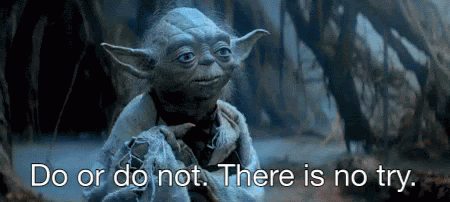
A healthy team will commit to doing something and follow through on that promise.
Practice Continuous Improvement
It’s crucial to learn from both your successes and failures.
You can always improve even if you feel you are already doing well.
Continuous improvement helps teams focus on the end goal.
Creating teams that thrive now and into the future
Building a healthy team isn’t a one-and-done process.
As your business takes advantage of new opportunities, you may have to revisit these ideas to ensure your teams remain collaborative and productive.
Stay focused on your vision and create healthy teams that work together well, contribute fully to your goals, and are willing to grow and improve.
Looking for more business advice? Be sure to check out our other articles for additional tips on how to run your business successfully.


